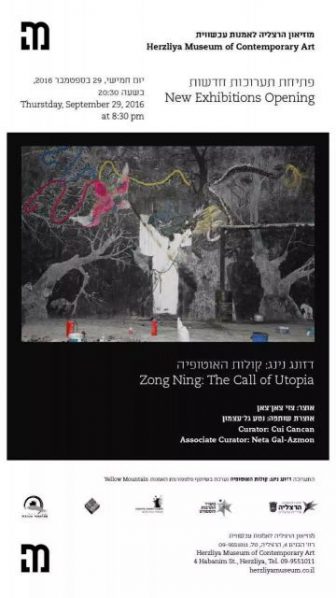
The installations of Zong Ning (b. 1984, Mongolia; lives and works in Beijing, China) combine painting, photography, and found objects, and in many cases performances, too. His works draw on Chinese culture yet also make reference to western culture. Zong Ning’s works often refer to conceptual pairs such as exterior and interior, micro and macro, chaos and order, or life and death, considered opposites by western culture; however, in Chinese culture, which regards Yin and Yang as inextricable parts of all things, they are seen as complementary. According to this outlook, nothing isabsolute, perfect or pure, and all is in constant flux. This thinking finds diverse expressions in the artist’s work: he paints wild exterior landscapes within the museum’s interior; attaches to huge paintings small-scale photos of them, a concrete demonstration of the belief that local, seemingly banal events resonate in the universe’s grandest events and vice versa; and the pond water, symbolizing life and renewal, is set among images rendered in a dark palette that conveys gloom and despair.
Zong Ning accentuates the traditional Chinese outlook in order to offer scathing criticism of modern Chinese society and of the ways by which it deals with issues such as moving away from family values, class differences, contempt of human life, materialistic aspirations and distance from nature. For example, he uses a monochromatic palette and unprocesse draw materials to object seductive commercial art which, he says, “is not made with the heart.” The logs scattered across the gallery are a Buddhist symbol of rawness as containing the potential to be anything. In Dao culture, the wise person is often likened to an unprocessed log of wood, which is seen as close to the source of all things.
The installation’s form resembles that of a traditional Chinese garden, enclosed by walls and featuring plants, rocks, and water. The image of the water pond, on which photographs of the artist’s childhood are floating, is associated with movement, change, and flow. In this way, the artist invites us to experience the installation as part of a process of endless becoming both in the world around us and within ourselves – thereby rendering present another key element in Chinese philosophy: the notion of the “path” (in Chinese, Dao). However, contrary to traditional Chinese gardens, this one is full of menacing motifs and provokes unease. Zong Ning’s work is informed, at one and the same time, by belief in the transformative power of art on the one hand and a dystopian viewof reality characterized by fear and existential loneliness on the other. In this context, the artist quotes Milan Kundera, an author who has greatly influenced him, who writes in his story The Joke, “l(fā)ured on by the voice of utopia, they have squeezed their way through the gates of Paradise only to find, when the doors slam shut behind them, that they are in hell.”
Text by Neta Gal-Azmon
About the exhibition
Curators: Cui Cancan and Neta Gal-Azmon
Dates: Sep 29, 2016 - Dec 31, 2016
Opening: Sep 29, 2016, Thursday
Venue: Herzliya Museum of Contemporary Art
Organizer: Blue Mountain Contemporary Art (Israel)
Courtesy of the artist and Herzliya Museum of Contemporary Art, for further information please visit www.herzliyamuseum.co.il.




























